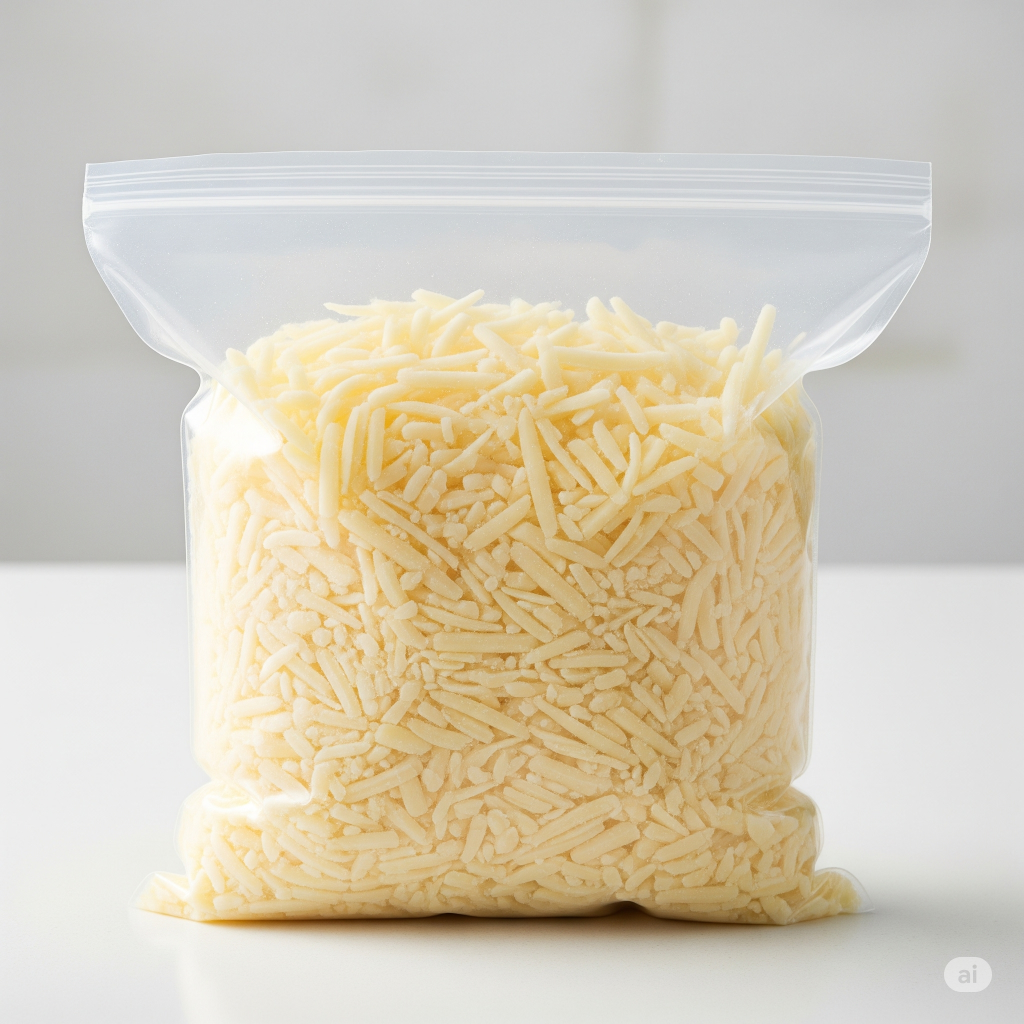Yes, you absolutely can freeze shredded parmesan cheese. 1 Because parmesan is a hard cheese with low moisture, it freezes remarkably well compared to softer cheeses.
Ever find yourself with a big bag of shredded parmesan after pasta night, or maybe you grabbed a great deal at the store? It happens! Then you start wondering, “What do I do with all this delicious cheese before it goes bad?”
Maybe you’ve thought about the freezer, but you’re not sure if that’s okay for parmesan. You might worry it will turn into a weird, icy block or lose all its yummy flavor.
Well, guess what? You absolutely can freeze shredded parmesan cheese, and it’s actually a fantastic way to save it for later.
Unlike some softer cheeses that get strange when frozen, parmesan holds up really well because it doesn’t have a lot of moisture. Freezing is a super simple trick to stop wasting that tasty cheese.
Stick around, and we’ll show you the best way to freeze your shredded parmesan so it stays fresh and ready for your next pizza, pasta, or salad. We’ll cover how to pack it, what happens to it in the freezer, and how to thaw it out perfectly. Let’s get freezing.

Can You Freeze Shredded Parmesan Cheese?
Yes, you absolutely can freeze shredded Parmesan cheese.
Here’s what you need to know:
Why it works
Parmesan is a hard, aged cheese with low moisture content. This makes it freeze much better than softer, high-moisture cheeses.
Texture Changes
While freezing is safe and effective for extending shelf life, it can slightly alter the texture. Upon thawing, the Parmesan might become a bit crumblier or slightly drier than fresh.
Best Uses After Freezing
Because of the potential texture change, frozen and thawed Parmesan is ideal for use in cooked dishes where it will be melted, such as sauces, soups, casseroles, or sprinkled on top of dishes before baking.
It might not be as ideal for uses where texture is paramount, like shaving over a salad, though many people don’t notice a significant difference.
How to Freeze?
- Ensure the cheese is dry.
- Place the shredded Parmesan in an airtight container or a heavy-duty freezer bag.
- Squeeze out as much air as possible before sealing the bag to prevent freezer burn. You might consider double-bagging for extra protection.
- Label the bag or container with the date.
Storage Time
Properly stored, shredded Parmesan can last in the freezer for about 6 months or even longer while maintaining decent quality.
Thawing
Thaw the cheese in the refrigerator when you’re ready to use it. You can often use it directly from the freezer in cooking applications.
Freezing is a great way to preserve leftover shredded Parmesan or to store bulk purchases.
Why Freeze Parmesan Cheese? The Benefits
So, why even bother freezing parmesan? Isn’t the fridge good enough? Well, sometimes! But freezing has some awesome advantages:
Make it Last WAY Longer
In the fridge, shredded parmesan might last a few weeks or maybe a month or two if it’s unopened. But in the freezer? You can extend its shelf life by months! This means less worry about using it up quickly.
Stop Wasting Food (and Money)
Have you ever found an opened bag of parmesan hiding in the back of the fridge, looking a bit sad and dry? Freezing stops that! It’s a super way to reduce food waste. Instead of tossing cheese that’s getting old, you freeze it for later.
Save Some Cash
Sometimes you find a giant bag of parmesan on sale, or maybe you buy a big wedge because it’s cheaper. Freezing lets you take advantage of those deals without worrying about the cheese going bad before you can finish it.
Always Ready
Imagine needing just a sprinkle of parmesan for your soup or pasta, and bam! You have some ready to go right in your freezer. It’s super convenient to have it on hand whenever you need it.
Freezing is basically like hitting the pause button on your cheese, keeping it good until you’re ready to enjoy it again.
Does Freezing Affect Parmesan Cheese? (Texture & Flavor)
Parmesan is a hard cheese, which means it doesn’t have much water inside. Cheeses with lots of water (like cream cheese or ricotta) can get icy and weird when frozen.
But parmesan’s low moisture content helps it handle the cold like a champ. This makes freezing hard cheese much easier than freezing soft cheese.
What about the Texture?
- Shredded: For frozen parmesan texture, you’ll barely notice a difference with shredded cheese. The biggest thing is that it might clump together a bit. Don’t worry, we’ll show you how to prevent that later!
- Block (if you freeze a whole piece): If you freeze a solid block of parmesan, it might become crumblier after thawing. This can make it harder to slice nicely, but it’s still perfectly fine for grating or crumbling into dishes.
Does the Flavor Change?
Usually, the flavor stays pretty much the same, especially if you use the cheese within about 3-6 months and store it right.
If you eat it plain right after thawing, you might notice a tiny difference, but once you cook it into sauces or sprinkle it on pizza, most people can’t tell it was ever frozen. The effects of freezing parmesan on flavor are usually very small.
So, while there might be tiny changes, freezing doesn’t ruin parmesan, especially shredded!
How to Freeze Shredded Parmesan Cheese: Step-by-Step
Ready to become a parmesan-freezing pro? It’s easy! Here’s how to freeze shredded parmesan the right way:
Get Your Cheese Ready
Store-Bought Shreds vs. Grating Your Own: You can freeze the parmesan that already comes shredded in a bag. These often have stuff added to stop clumping, which helps in the freezer too!
Or, you can grate your own from a block using a food processor or a regular box grater for the freshest flavor. Both work!
Pack it Right (This is Super Important)
Air is the enemy in the freezer – it causes “freezer burn” (those dry, icy spots). You want to keep as much air away from your cheese as possible.
Option 1: Freezer Bag or Container
Put your shredded parmesan directly into a sturdy freezer bag or an airtight container.
Get the Air Out! If using a bag, squeeze out as much air as you can before sealing it. Press it flat. You can even seal it almost shut, stick a straw in the corner, suck the last bit of air out, and quickly seal it completely.
For containers, choose one that’s just the right size so there isn’t much empty space.
Option 2: Flash Freezing (The Best Way to Prevent Clumping)
This extra step really helps prevent clumping frozen cheese. Spread the shredded parmesan in a single, thin layer on a baking sheet lined with parchment paper (so it doesn’t stick).
Put the baking sheet flat in the freezer for about 30-60 minutes, just until the shreds are firm.
Once frozen, scoop the loose shreds into your freezer bag or airtight container. Now they won’t stick together in one big lump! Remember to squeeze out the excess air before sealing.
Label It
Grab a marker and write “Shredded Parmesan” and the date you froze it on the bag or container. This way, you know what it is and how long it’s been in there.
That’s it! Your parmesan is ready for its chilly nap.
How Long Does Frozen Shredded Parmesan Last?
So, you’ve packed your parmesan perfectly. How long does frozen parmesan last in the freezer?
Best Quality
For the best taste and texture, try to use your frozen shredded parmesan within 3 to 6 months.
Can it Last Longer? Some folks say it can last up to a year, and it will likely still be safe to eat if stored properly. However, after about 6 months, you might start to notice more changes in texture or a slight loss of flavor.
Storage Matters
Keeping it in a truly airtight container or well-sealed bag is key to making it last longer and taste better. The less air gets to it, the better!
Signs It’s Time to Go
Look out for lots of ice crystals inside the bag (this is freezer burn parmesan), a very dry or crumbly look, or any weird smells when you open it (though smells are rare if it was sealed well). If it looks or smells off, it’s best to toss it.
Remember that label with the date? It helps you use the oldest cheese first!
How to Thaw and Use Frozen Shredded Parmesan?
Okay, your parmesan has been chilling out. Now it’s time to use it! Here’s how to thaw frozen parmesan and put it to good use:
Thawing Methods
In the Fridge (Best Way): This is the safest and usually the best method for quality. Just move the container or bag from the freezer to the refrigerator. Let it sit for several hours or overnight. It will thaw gently.
Use it Frozen (Perfect for Cooking!): Here’s a great shortcut! For most cooking with frozen cheese, you don’t even need to thaw it.
Just sprinkle the frozen shredded parmesan directly onto hot pasta, into sauces as they simmer, onto pizzas before baking, or into casseroles. The heat from the dish will thaw and melt it perfectly. This is often the easiest way!
On the Counter (Use Caution)
You can leave it on the counter for a short time to thaw, but it’s generally not the best idea for food safety or quality, especially if it’s warm in your kitchen. If you do this, use the cheese quickly once it’s thawed.
Best Ways to Use Frozen Parmesan
Frozen parmesan shines in cooked dishes where it melts – think pasta sauces, lasagna, baked ziti, sprinkled over soup, or baked onto garlic bread.
It might not be the absolute best choice for something like a fancy cheese platter where you eat it raw, as the texture might be slightly different, but honestly, most people won’t notice much difference, especially if it was flash-frozen.
Dealing with Clumps
If your parmesan clumped up a bit despite your best efforts, don’t worry! Once it’s thawed slightly (or even while frozen), you can usually break it up easily by shaking the bag vigorously or gently crumbling it with your fingers or a fork.
Quick Tips for Freezing Success
Want to make sure your frozen parmesan experience is awesome? Here are a few extra pointers:
Start Fresh
Freezing won’t make old cheese better. Use parmesan that’s still fresh and good quality for the best results.
Double Up
For extra protection against freezer burn, you can put your sealed freezer bag inside another freezer bag.
Freeze Smart Portions
Think about how much parmesan you usually use at one time. Freeze it in smaller bags or containers so you only thaw what you need.
Don’t Toss the Rind
Got a parmesan rind? Freeze it too! Keep it in a separate bag. Toss the frozen rind into simmering soups, stews, or sauces for amazing extra flavor (just remember to pull it out before serving!).
No Refreezing
Once you’ve thawed parmesan cheese, it’s best not to freeze it again. Thawing and refreezing can make the texture less pleasant.
FAQs
Can you freeze a whole block of Parmesan?
Yes! Wrap it very tightly in plastic wrap, then put it in a freezer bag with the air squeezed out, or wrap it in foil. Just remember, it might get crumbly after thawing, making it better for grating than slicing.
Can you freeze Kraft-style or other parmesan in a shaker can?
Yep! These often already contain ingredients to prevent caking, so they usually freeze and thaw without much fuss. Just make sure the lid is tight, or transfer it to an airtight bag/container for better protection.
Will frozen parmesan melt properly?
Absolutely. Frozen parmesan generally melts just fine when added to hot dishes or baked. You shouldn’t notice any difference in how it melts compared to fresh parmesan.
Is it better to freeze or refrigerate parmesan?
It depends on how quickly you’ll use it. Refrigeration is perfect if you’ll eat the parmesan within a few weeks or maybe a couple of months. Freezing is the way to go for long-term storage to keep it fresh for many months.
Conclusion
So, there you have it! Freezing shredded parmesan cheese is totally possible, super easy, and a fantastic way to keep that delicious cheesy goodness around for longer.
We learned that it freezes well because it’s a hard, low-moisture cheese, and the steps to freeze it are simple – just pack it well to keep the air out! Remember the biggest benefits: you’ll reduce food waste, save money by buying bigger amounts, and always have convenient parmesan ready for your favorite meals.
Why not give it a try next time you have extra parmesan? You’ll be surprised how simple and effective it is. Let us know in the comments if you try it or if you have any other cheese-freezing tips.














